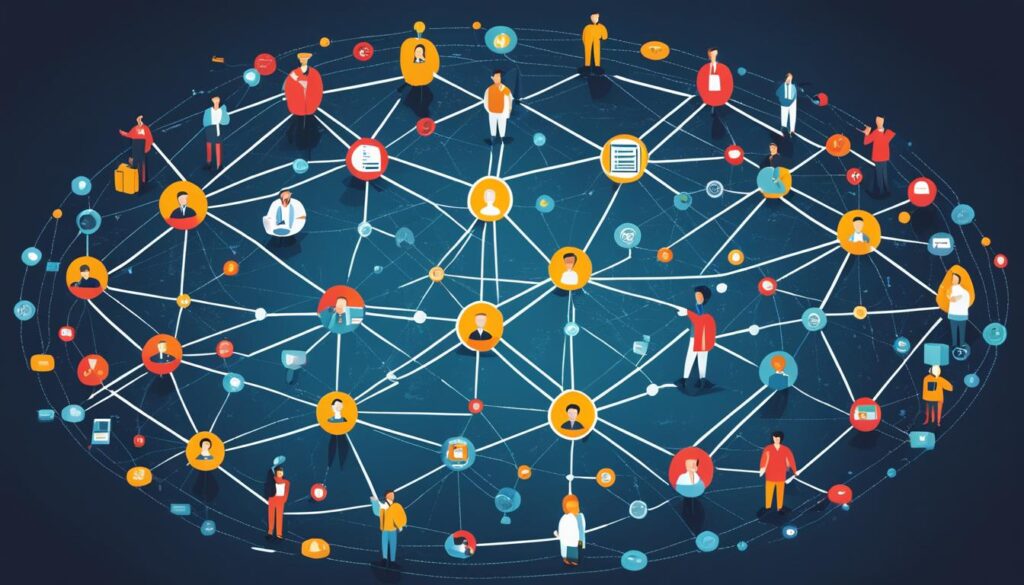Emerging technologies are revolutionizing how we approach professional training. Tools like AI, AR, VR, and machine learning are creating immersive and personalized learning experiences. These advancements are not just enhancing traditional methods but also adding context and safety to training programs.
For instance, flight simulation training demonstrates how technology can improve performance and safety. By integrating these tools, organizations can design tailored learning journeys that meet individual needs. This shift is transforming the way we prepare for future workforce challenges.
Investments in these innovations are growing rapidly, driven by their proven effectiveness. AI and machine learning analyze data to predict outcomes, while AR and VR deliver engaging, hands-on experiences. These technologies are reshaping the learning environment, making it more interactive and impactful.
As we explore these advancements, it’s clear that technology is a cornerstone of modern professional training. Its ability to adapt and innovate ensures that learners are equipped with the skills needed in an ever-evolving world.
Key Takeaways
- Emerging technologies like AI, AR, and VR are transforming professional training.
- Personalized learning journeys are becoming the new standard.
- Immersive experiences enhance safety and performance in training programs.
- Real-world applications, such as flight simulations, showcase these benefits.
- Investments in new technology are driving innovation in the learning environment.
Introduction to the Future of Professional Training
Digital innovations are reshaping how organizations approach workforce development. Rapid advancements in tools and platforms are creating a dynamic environment for skill-building. These changes are not just about adopting new systems but also about rethinking how we prepare employees for modern challenges.
Current trends highlight a shift toward more personalized and immersive learning experiences. Organizations are leveraging tools like AI and AR to design programs that cater to individual needs. This approach ensures that employees gain relevant skills while staying engaged in their development.

Systems and platforms are adapting to deliver real-time solutions. For example, AR and VR provide hands-on experiences that mimic real-world scenarios. These technologies bridge the gap between theory and practice, making learning more effective and impactful.
Staying competitive in today’s fast-paced market requires embracing these trends. Companies that invest in innovative training methods are better positioned to address workforce challenges. By focusing on continuous skill development, organizations can ensure their teams remain adaptable and future-ready.
Overview of Technological Trends
Emerging tools are transforming how we approach work and training. AI-driven platforms analyze data to identify gaps and recommend tailored solutions. This level of personalization enhances the overall effectiveness of training programs.
Immersive technologies like AR and VR are also gaining traction. They offer interactive experiences that simulate real-world tasks, making learning more engaging. These tools are particularly valuable in industries where hands-on experience is critical.
As these trends evolve, they are shaping a new standard for professional development. Organizations that embrace these innovations will lead the way in building a skilled and adaptable workforce. The future of training lies in leveraging technology to create meaningful and impactful learning journeys.
The Impact of Technology on the Future of Professional Training
Cutting-edge solutions are enhancing skill-building programs. Innovations in digital tools are transforming how we deliver training, making it more dynamic and interactive. Gone are the days of static methods; today’s programs focus on engaging learners through immersive experiences.
Data shows that technology-driven training improves both performance and safety. For example, VR and AR simulate real-world scenarios, allowing employees to practice without risk. These tools are particularly valuable in industries like healthcare and aviation, where hands-on experience is critical.

Digital advancements are also redefining job requirements. As automation grows, roles are evolving, and employees need new skills to stay relevant. This shift is reshaping education approaches, emphasizing continuous learning and adaptability.
Understanding these changes is essential for designing effective programs. Organizations must leverage technology to create training that meets future job demands. By doing so, they can ensure their workforce remains competitive and prepared for challenges ahead.
| Technology | Benefit | Industry Example |
|---|---|---|
| VR/AR | Immersive learning | Healthcare, Aviation |
| AI | Personalized training | Manufacturing |
| Mobile Learning | Accessibility | Remote Work |
In conclusion, technology is reshaping education and job roles. By embracing these innovations, organizations can create impactful training programs that prepare employees for the future. The key lies in staying adaptable and leveraging tools that enhance learning and performance.
Emerging Technologies and Their Role in Professional Training
Innovative tools are reshaping the way we approach skill development. Technologies like AI, AR, and VR are creating immersive, context-rich environments that cater to individual needs. These advancements allow learners to practice complex tasks in a safe, error-friendly space, similar to flight simulators.

These technologies are transforming how we prepare for modern challenges. They provide hands-on experiences that mimic real-world scenarios, making learning more engaging and effective. This approach ensures that every person can develop the skills needed for their specific roles.
Artificial Intelligence, AR, and VR Innovations
AI, AR, and VR are at the forefront of modern training. AI analyzes data to personalize learning paths, while AR and VR create interactive simulations. These tools are particularly useful for tasks that require precision and practice, such as medical procedures or machinery operation.
For example, VR simulations allow learners to practice high-risk tasks without real-world consequences. This characteristic of immersive learning ensures that employees gain confidence and competence before applying their skills on the job.
Benefits for Learners and Organizations
These technologies offer dual advantages. For learners, they provide engaging, personalized experiences that enhance skill retention. For organizations, they reduce training risks and improve overall performance.
According to industry insights, immersive training environments boost engagement and profitability by 21%. This makes them a valuable investment for companies looking to stay competitive.
| Technology | Key Benefit | Application |
|---|---|---|
| AI | Personalized Learning | Corporate Training |
| AR | Interactive Simulations | Healthcare |
| VR | Error-Friendly Practice | Aviation |
In summary, emerging technologies are revolutionizing professional training. By leveraging AI, AR, and VR, organizations can create dynamic learning environments that prepare individuals for future challenges. These tools not only enhance skill development but also optimize training outcomes for businesses.
Integrating New Technology in the Learning Environment
Modern tools are reshaping how we approach learning environments. To maximize their potential, we must focus on seamless integration into existing systems. This ensures that digital tools enhance rather than disrupt training programs.
Supporting systems for real-time feedback and personalization are critical. They allow learners to track progress and adapt to challenges. This approach fosters a more engaging and effective learning experience.

Key Strategies for Technology Integration
Effective deployment of digital tools requires a strategic approach. Here are some methods to ensure success:
- Seamless Integration: Align new tools with current systems to avoid disruptions.
- Continuous Learning: Design programs that adapt to evolving technological trends.
- Personal and Organizational Development: Focus on skill-building for both individuals and teams.
- Future Planning: Anticipate advancements to keep training programs relevant.
For example, 90% of teachers believe technology positively impacts engagement. By leveraging these insights, we can create dynamic learning environments that meet diverse needs.
Planning for future advancements ensures long-term success. As technology evolves, so must our strategies. This proactive approach guarantees that training programs remain effective and impactful.
Harnessing Artificial Intelligence for Training Enhancement
AI-driven solutions are redefining personalized training experiences. By leveraging artificial intelligence, organizations can create dynamic learning environments that adapt to individual needs. This approach ensures that every learner receives tailored support, enhancing both engagement and outcomes.

AI-Driven Learning Personalization
AI algorithms analyze learner behavior and performance to provide real-time feedback. This data-driven approach identifies skill gaps and recommends targeted interventions. For example, virtual mentors powered by AI deliver personalized training recommendations, ensuring learners stay on track.
Studies show that AI-driven adaptive learning platforms can increase engagement by up to 50%. These tools also enhance knowledge retention rates by 30% compared to traditional methods. By automating feedback and assessments, AI streamlines the learning process, making it more efficient and effective.
Specific instances, such as automated mentoring solutions, highlight AI’s transformative potential. These systems interface with back-end platforms to offer actionable insights, creating a seamless experience for users. This level of personalization ensures that training programs remain relevant and impactful.
| AI Application | Benefit | Example |
|---|---|---|
| Adaptive Learning | Personalized Paths | Corporate Training |
| Virtual Mentors | Real-Time Feedback | Healthcare |
| Predictive Analytics | Skill Gap Identification | Manufacturing |
Using AI in learning design allows organizations to adapt training strategies swiftly. This adaptability ensures that programs evolve with changing demands, keeping learners prepared for future challenges. By integrating AI, companies can maximize the effectiveness of their training initiatives.
Exploring the Potential of Virtual Reality and Augmented Reality in Learning
Immersive technologies like VR and AR are unlocking new possibilities in learning and development. These tools create engaging, hands-on experiences that simulate real-world environments. By doing so, they allow learners to practice skills in a safe and controlled setting.

Studies show that VR and AR can significantly enhance retention rates. For instance, 75% of employees trained with VR experience better knowledge retention compared to traditional methods. This datum highlights the effectiveness of immersive learning.
Creating Immersive Learning Scenarios
VR and AR introduce fully immersive training scenarios. These technologies simulate real-world tasks, enabling learners to practice without real-life consequences. For example, medical professionals can perform virtual surgeries, reducing risks and improving confidence.
Such environments empower employees to explore new roles and responsibilities. They also provide detailed performance monitoring, helping trainers identify areas for improvement. This approach ensures that learning is both effective and engaging.
VR/AR Impact on Skill Development
Immersive technologies are transforming skill development. They offer experiential learning opportunities that traditional methods cannot match. For instance, VR training at Walmart led to a 10-15% increase in employee performance.
Key benefits include:
- Safe Practice: Learners can make mistakes without real-world consequences.
- Enhanced Engagement: Interactive simulations keep learners motivated.
- Real-Time Feedback: Performance data helps refine skills quickly.
To learn more about how Augmented Reality in learning is shaping the future, explore our detailed insights.
Machine Learning Applications in Corporate Learning
Machine learning is transforming corporate learning by analyzing vast amounts of data to optimize training strategies. This technology enables organizations to measure training effectiveness and predict outcomes with precision. By leveraging data-driven insights, companies can create more efficient and impactful learning programs.

One of the key benefits of machine learning is its ability to streamline research and analysis. It processes complex datasets to identify patterns and trends, helping organizations understand what works and what doesn’t. This saves time and resources while improving the overall effect of training initiatives.
Data-Driven Decision Making in Training
Machine learning empowers organizations to make informed decisions based on real-time data. For example, it can predict learner success by analyzing performance metrics and engagement levels. This allows trainers to adjust methods and content delivery to meet individual needs.
Additionally, machine learning identifies trends in learning behavior. It helps optimize content delivery by tailoring materials to specific audiences. This personalized approach ensures that employees gain the skills they need to succeed in their roles.
By integrating machine learning tools, companies create agile and responsive training environments. These systems adapt to changing demands, ensuring that learning programs remain relevant and effective. This forward-thinking approach prepares organizations for future challenges in workforce development.
The Evolving Job Landscape in the Age of Automation
Automation is reshaping the job landscape, creating new challenges and opportunities. Industries are witnessing a shift in roles and responsibilities as machines take over repetitive tasks. This transformation requires workers to adapt and acquire new skills to stay relevant.
One of the key changes is the demand for advanced technical skills. As automation grows, roles that rely on manual or routine tasks are declining. Instead, there’s a rising need for expertise in areas like AI, data analysis, and digital literacy. This shift highlights the importance of continuous learning and skill development.
Adapting to Changing Work Characteristics
Automation is altering how work is performed across industries. For example, in manufacturing, robots handle assembly lines, while in healthcare, AI assists in diagnostics. These changes require workers to adapt to new tools and processes. Organizations must provide training to help employees navigate these transitions.
Another critical aspect is the need for information management. With automation generating vast amounts of data, workers must learn to analyze and interpret this information effectively. This skill is becoming essential in decision-making and strategy development.
Opportunities for Upskilling and Career Transition
While automation poses challenges, it also opens doors for career growth. Workers can leverage upskilling programs to transition into high-demand roles. For instance, a retail worker might train in digital marketing or e-commerce to remain competitive.
Educational institutions and employers are collaborating to create tailored training content. These programs focus on equipping individuals with the skills needed for emerging job markets. By embracing these opportunities, workers can future-proof their careers.
In conclusion, automation is reshaping the workforce, demanding adaptability and continuous learning. By addressing these changes, organizations and individuals can thrive in this evolving landscape.
Workforce Development and Upskilling in a Digital Era
Adapting to the digital era requires a proactive approach to workforce development. As digital tools evolve, organizations must focus on continuous upskilling to meet changing demands. This shift ensures employees remain competitive and equipped for future challenges.
Current trends highlight the need for ongoing skill enhancement. Employees expect training programs that adapt to their unique needs. By leveraging digital tools, organizations can create tailored learning experiences that drive success.
Learning Strategies for Today’s Workforce
Effective learning strategies are essential in a digital-first world. Adaptive technologies, such as AI and machine learning, help identify skill gaps. These tools provide personalized recommendations, ensuring employees gain relevant expertise.
Collaborative approaches also play a critical role. Combining self-directed learning with guided initiatives fosters engagement and retention. For example, mentorship programs and peer learning opportunities enhance skill development.
Organizations must seize the opportunity to integrate digital tools into training programs. This approach not only addresses skill gaps but also prepares employees for emerging roles. By investing in upskilling, companies can build a future-ready workforce.
Customization and Mass-Personalization in Learning Experiences
Data-driven insights are reshaping how we design learning experiences. The growing trend of mass-personalization allows organizations to create tailored programs that meet individual needs. This approach ensures that every learner receives the right content at the right level, enhancing their overall knowledge and performance.
Leveraging Big Data for Personalized Training
Big data plays a pivotal role in personalizing training. By analyzing learner behavior and performance, organizations can identify gaps and deliver targeted interventions. For example, adaptive learning platforms use algorithms to recommend content that aligns with individual goals. This method ensures sustained change in skill development.
Case studies show that personalized training improves retention rates by up to 30%. Companies like Walmart and IBM have successfully implemented these strategies, resulting in measurable performance gains. By leveraging data, organizations can create dynamic learning environments that adapt to evolving needs.
Innovative Approaches to Learner Engagement
Engaging learners requires innovative methods. Interactive platforms, gamification, and microlearning are transforming how we approach training. These tools make learning more accessible and enjoyable, fostering higher engagement levels.
For instance, gamified training programs increase participation by 60%. Similarly, microlearning modules allow learners to absorb information in bite-sized chunks, improving retention. These approaches ensure that training remains relevant and impactful in a fast-paced world.
In conclusion, customization and mass-personalization are redefining learning experiences. By leveraging big data and innovative tools, organizations can create programs that drive meaningful change and prepare learners for future challenges.
Bridging Theory and Practice in Modern Training Environments
Effective training programs now focus on merging classroom theories with real-world applications. This approach ensures learners gain both knowledge and practical skills. By harmonizing these elements, we create environments where the workforce can thrive.
Hands-on training has proven to bridge the gap between theory and practice. For example, simulation-based medical education improves clinical skills in a safe setting. This method allows learners to apply concepts in realistic scenarios, enhancing their ability to perform under pressure.
Strategies for integrating instructional design with operational realities are essential. Practical exercises, simulations, and real-time feedback ensure learners grasp concepts effectively. These methods not only reinforce theoretical knowledge but also build confidence in applying it.
Our approach prepares the workforce to solve real-world problems. By combining theory with practice, we equip individuals with the skills needed for modern challenges. This balance is the way forward in creating impactful training programs.
| Strategy | Benefit | Example |
|---|---|---|
| Simulations | Safe practice environment | Medical training |
| Real-time feedback | Immediate skill improvement | Aviation training |
| Practical exercises | Enhanced retention | Manufacturing training |
In conclusion, bridging theory and practice is vital for modern training environments. By focusing on practical application, we ensure learners are prepared for the challenges of today’s workforce. This approach fosters both competence and confidence.
Balancing Human Touch and Technological Advancements in Training
Maintaining a balance between human interaction and technological tools is essential for effective training. While automation and AI streamline processes, the human element remains irreplaceable. This balance ensures that learners feel supported and engaged throughout their development.
Strategies for integrating technology with personalized feedback are critical. Tools like facial recognition and wearable analytics provide data-driven insights. However, combining these with human mentorship creates a holistic learning experience.
Enhancing Feedback and Collaboration
Continuous feedback is key to growth. Technology can track progress and identify areas for improvement. Yet, human trainers offer empathy and context that machines cannot replicate.
Collaborative practices, such as peer reviews and group projects, foster teamwork. These methods encourage learners to share knowledge and build trust. This blend of technology and human interaction ensures a well-rounded training approach.
Throughout the year, organizations must prioritize this balance. By leveraging technology to enhance, not replace, human connections, we create effective and meaningful training programs. This thoughtful design prepares learners for success in an evolving world.
Research Insights and Evidence from Thought Leaders
Thought leaders and empirical studies provide valuable insights into the effectiveness of modern learning tools. Their findings validate the transformative power of innovative training methods. By leveraging data-driven approaches, organizations can address the need for continuous improvement in skill development.
Key Findings from Industry Experts
Industry leaders emphasize the role of emerging technologies in enhancing training outcomes. For example, AI-driven platforms analyze learner behavior to identify skill gaps. This tool ensures personalized learning paths, boosting engagement and retention.
Experts also highlight the importance of immersive experiences. VR and AR simulations provide hands-on practice, reducing risks in high-stakes environments. These methods are particularly effective in industries like healthcare and aviation.
Analysis of Empirical Studies
Studies reveal measurable benefits of integrating technology into training. For instance, 75% of employees trained with VR report better knowledge retention. This data underscores the effectiveness of immersive learning.
Machine learning algorithms also play a critical role. They process vast datasets to predict outcomes and optimize training strategies. This approach ensures programs remain relevant and impactful.
| Technology | Benefit | Industry Example |
|---|---|---|
| AI | Personalized Learning | Corporate Training |
| VR/AR | Immersive Practice | Healthcare |
| Machine Learning | Data-Driven Insights | Manufacturing |
In conclusion, research and expert insights highlight the value of modern learning tools. By adopting these technologies, organizations can create effective training programs that prepare employees for future challenges.
Addressing Workplace Challenges in the Era of Disruptive Technology
Disruptive advancements are reshaping workplace dynamics, requiring innovative solutions to address emerging challenges. As automation and AI become more prevalent, organizations must adapt to ensure employees remain skilled and competitive. This shift demands a proactive approach to training and development.
Mitigating Risks of Automation
Automation brings efficiency but also risks to job roles. To mitigate these risks, organizations must focus on reskilling and upskilling employees. For example, roles in manufacturing and administrative support are highly exposed to automation. By providing targeted training, companies can help workers transition into new roles.
Strategies include:
- Reskilling Programs: Offering courses in AI, data analysis, and digital literacy.
- Career Transition Support: Helping employees move into less exposed roles.
- Continuous Learning: Encouraging lifelong skill development to stay relevant.
Innovative Solutions for Job Training
Integrating technology into training programs can enhance learning outcomes. AI-driven platforms analyze employee performance to identify skill gaps. This intelligence ensures personalized learning paths, boosting engagement and retention.
Immersive technologies like VR and AR provide hands-on practice in safe environments. For instance, healthcare professionals use VR simulations to practice surgeries. These tools not only improve skills but also build confidence.
By adopting these solutions, organizations can create a resilient workforce. This approach adds significant value to both employees and employers, ensuring long-term success.
| Strategy | Benefit | Example |
|---|---|---|
| Reskilling Programs | Transition to new roles | Manufacturing |
| AI-Driven Platforms | Personalized learning | Corporate Training |
| VR/AR Simulations | Safe practice environment | Healthcare |
Conclusion
As we look ahead, it’s clear that innovative tools are transforming how we prepare for workplace challenges. From AI to VR, these advancements redefine learning, making it more immersive and effective. Our guide has highlighted key strategies to adapt to this evolving landscape.
Continuous evolution in training methods is essential to meet the demands of a changing reality. Organizations must embrace these shifts to stay competitive. By integrating modern tools, they can create impactful programs that prepare employees for future roles.
We invite educators and businesses to actively shape the future of learning. By leveraging technology and fostering adaptability, they can ensure a skilled and resilient workforce. Together, we can build a foundation for success in an ever-changing world.
Source Links
- The Future of Corporate Learning: Stepping Into Another Dimension – https://trainingindustry.com/magazine/july-aug-2017/the-future-of-corporate-learning-stepping-into-another-dimension/
- Training & Upskilling at Scale: How Technology is Shaping the Future Manufacturing Workforce – https://www.qualitymag.com/articles/98134-training-and-upskilling-at-scale-how-technology-is-shaping-the-future-manufacturing-workforce
- The Future of Jobs and Jobs Training – https://www.pewresearch.org/internet/2017/05/03/the-future-of-jobs-and-jobs-training/
- Predicting the unpredictable: How will technology change the future of work? – https://www2.deloitte.com/us/en/insights/focus/technology-and-the-future-of-work/rethinking-future-of-work-models-to-predict-the-unpredictable.html
- The Impact of Technology on Employee Training and Development – https://www.alignmark.com/2023/12/15/the-impact-of-technology-on-employee-training-and-development/
- The Impact of Technology on Learning and Development – https://www.glptraining.co.uk/post/the-impact-of-technology-on-learning-and-development
- Frontiers | The Effects of Technological Developments on Work and Their Implications for Continuous Vocational Education and Training: A Systematic Review – https://www.frontiersin.org/journals/psychology/articles/10.3389/fpsyg.2020.00918/full
- The Impact of Emerging Technologies on Employers, Workers, Job Seekers, and Students | American Institutes for Research – https://www.air.org/resource/spotlight/impact-emerging-technologies-employers-workers-job-seekers-and-students
- 6 Ways Technology Can Enhance Employee Training – https://www.waybook.com/blog/6-ways-technology-can-enhance-employee-training
- How to Integrate Technology in the Classroom – School of Education – https://drexel.edu/soe/resources/student-teaching/advice/how-to-use-technology-in-the-classroom/
- Future of Technology in Education: Benefits and Trends – https://forbytes.com/blog/future-of-technology-in-education/
- Harnessing the Power of AI in Training and Development – https://www.td.org/content/atd-blog/harnessing-the-power-of-ai-in-training-and-development
- Harnessing the Power of AI in Learning & Performance: Practical Insights for Maximizing Impact – https://www.kirkpatrickpartners.com/blog/harnessing-the-power-of-ai-in-learning-performance-practical-insights-for-maximizing-impact/
- Impact of Virtual Reality and Augmented Reality in Training and Development – https://psico-smart.com/en/blogs/blog-impact-of-virtual-reality-and-augmented-reality-in-training-and-development-12210
- The Future of Learning Experiences – VirtualSpeech – https://virtualspeech.com/blog/augmented-virtual-reality-future-of-learning-experience
- Role of Technology in Employee Training & Development (2025) – https://www.edstellar.com/blog/role-of-modern-technology-in-employee-training
- Revolutionizing eLearning: The Future Impact Of AI And Machine Learning – https://elearningindustry.com/revolutionizing-elearning-the-future-impact-of-ai-and-machine-learning
- Insights on Generative AI and the Future of Work – https://www.commerce.nc.gov/news/the-lead-feed/generative-ai-and-future-work
- Skill shift: Automation and the future of the workforce – https://www.mckinsey.com/featured-insights/future-of-work/skill-shift-automation-and-the-future-of-the-workforce
- The Future Of Work: Embracing AI’s Job Creation Potential – https://www.forbes.com/councils/forbestechcouncil/2024/03/12/the-future-of-work-embracing-ais-job-creation-potential/
- Understanding the impact of automation on workers, jobs, and wages – https://www.brookings.edu/articles/understanding-the-impact-of-automation-on-workers-jobs-and-wages/
- The business case for digitally upskilling the workforce – HRD – https://www.hrdconnect.com/2024/04/18/the-business-case-for-digitally-upskilling-the-workforce/
- The Importance of Upskilling for Future Professional Growth – https://www.apu.apus.edu/area-of-study/business-and-management/resources/the-importance-of-upskilling-for-future-professional-growth/
- Technology in the Classroom: Insights for Optimization – https://www.edelements.com/technology-in-classroom
- Personalized Education for All: The Future of Open Universities | Open Praxis – https://openpraxis.org/articles/10.55982/openpraxis.16.1.612
- Future of Education Technology in 2025: Trends in Ed-Tech and Opinions of Industry’s Most Thought Leaders – https://www.educate-me.co/blog/future-of-education-technology
- Bridging theory and practice: enhancing medical education through simulation-based training methods – https://mjhs.md/article/bridging-theory-and-practice-enhancing-medical-education-through-simulation-based-training
- Bridging Theory and Practice: Using Goal Systems to Spark Professional Dialogue and Develop Personal Theories – https://www.mdpi.com/2227-7102/14/5/458
- Impact of Technology on Nursing Education: Revolutionizing Learning – Davis & Elkins College – https://www.dewv.edu/impact-of-technology-on-nursing-education-revolutionizing-learning/
- How to Balance the Human Element and Technology to Improve Contact Center Training – https://trainingmag.com/how-to-balance-the-human-element-and-technology-to-improve-contact-center-training/
- Future of Work: Balancing Tech & Human Skills – https://www.adecco.com/en-gb/resources/striking-the-right-balance-between-talent-and-tech-the-value-of-human-skills
- Leading the Future of Work: SHRM’s Insights on Workforce Evolution – https://www.shrm.org/topics-tools/research/leading-future-of-work-insights-on-workforce-evolution
- CIPD | Technology and the Future of Work | Factsheets – https://www.cipd.org/en/knowledge/factsheets/emerging-future-work-factsheet/
- What can history teach us about technology and jobs? – https://www.mckinsey.com/featured-insights/future-of-work/what-can-history-teach-us-about-technology-and-jobs
- Educating and Training the Future Workforce: Challenges and Innovations in American Education and Industry – https://www.steptoe.com/en/news-publications/stepwise-risk-outlook/educating-and-training-the-future-workforce-challenges-and-innovations-in-american-education-and-industry.html
- Foreword – https://www.cedefop.europa.eu/files/5519_en.pdf
- How Will Disruptive Technologies Change Your Job and Workplace? – https://www.roberthalf.com/us/en/insights/career-development/how-will-disruptive-technologies-change-your-job-and-workplace
- Generative AI, the American worker, and the future of work – https://www.brookings.edu/articles/generative-ai-the-american-worker-and-the-future-of-work/
- Reskilling and Upskilling the Future-ready Workforce for Industry 4.0 and Beyond – https://pmc.ncbi.nlm.nih.gov/articles/PMC9278314/
- The Effects of Technological Developments on Work and Their Implications for Continuous Vocational Education and Training: A Systematic Review – https://pmc.ncbi.nlm.nih.gov/articles/PMC7226038/
- Technology, jobs, and the future of work – https://www.mckinsey.com/featured-insights/employment-and-growth/technology-jobs-and-the-future-of-work





